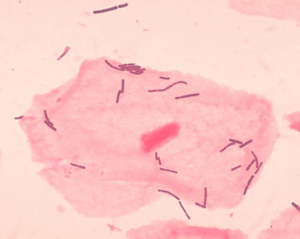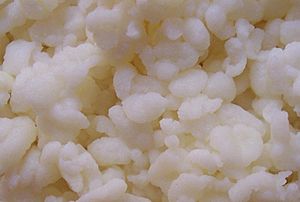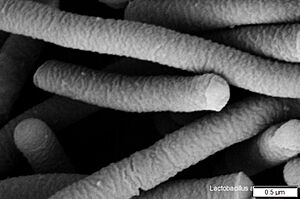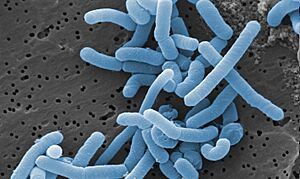Lactobacillus facts for kids
Quick facts for kids Lactobacillus |
|
|---|---|
 |
|
| Lactobacillus sp. near a squamous epithelial cell | |
| Scientific classification |
|
| Domain: | Bacteria |
| Phylum: | Firmicutes |
| Class: | Bacilli |
| Order: | Lactobacillales |
| Family: | Lactobacillaceae |
| Genus: | Lactobacillus Beijerinck 1901 (Approved Lists 1980) |
| Type species | |
| Lactobacillus delbrueckii (Leichmann 1896) Beijerinck 1927 (Approved Lists 1980)
|
|
| Species | |
|
See text |
|
Lactobacillus is a group of tiny living things called bacteria. They are shaped like rods and do not form spores. These bacteria are special because they can live with or without much air.
Until 2020, there were over 260 different types of Lactobacillus. Now, scientists have sorted them into 25 new groups. Lactobacillus bacteria are a big part of the microbes that live inside humans and animals. You can find them in places like the digestive system and the female reproductive system.
Contents
What are Probiotics?
Some Lactobacillus bacteria are known as probiotics. Probiotics are good bacteria that can help your body stay healthy. They are often found in certain foods and supplements.
How Probiotics Help Your Gut
Taking Lactobacillus along with other probiotics might help people with irritable bowel syndrome (IBS). IBS is a condition that affects the digestive system. While it can help, scientists are still learning exactly how much it benefits people.
Probiotics and Skin Health
In children, some Lactobacillus types, like Lacticaseibacillus rhamnosus, can help reduce a skin problem called atopic eczema, also known as dermatitis. These good bacteria release special substances that help calm down inflammation in the body.
Boosting Your Immune System
When Lactobacillus and other good bacteria are found in foods like ripened milk and yogurt, they can help your body's immune system. They do this by increasing the number of certain protective cells in your gut.
Lactobacillus and Your Teeth
Some types of Lactobacillus have been linked to dental caries, which are also called cavities. These bacteria can produce lactic acid, which can wear away tooth enamel. For a long time, dentists used to check the amount of Lactobacillus in saliva to see if someone was likely to get cavities.
However, the story is more complex! Recent studies show that some good Lactobacillus bacteria can actually help protect your teeth. They can settle on your teeth and prevent harmful bacteria from causing tooth decay.
New Research in Oral Health
The study of Lactobacillus and oral health is a newer field. Scientists are finding that some specific Lactobacillus species can act as probiotics for your mouth. Because of this, some chewing gums and lozenges now include these helpful bacteria. There is also evidence that certain Lactobacillus types can help protect against gum diseases like gingivitis.
Lactobacillus in Food Production
Lactobacillus bacteria are very important in making many of the foods we eat. They are a key part of the fermentation process. This is where microbes change sugars into other substances, like acids.
Making Fermented Foods
These bacteria are used to make foods like wine, yogurt, cheese, sauerkraut, pickles, beer, cider, kimchi, and kefir. They are also used in making cocoa and even animal feeds. Lactobacillus species are especially common in making yogurt, cheese, and sourdough bread.
How Fermentation Works
Lactobacillus bacteria produce substances that stop bad bacteria and fungi from growing. This helps to preserve food and gives it unique flavors.
Sourdough Bread
Sourdough bread is made using a "starter culture." This starter is a mix of yeast and Lactobacillus bacteria growing in water and flour. The bacteria eat the sugars in the flour and turn them into lactic acid. This acid gives sourdough its famous sour taste, just like yogurt or sauerkraut.
Pickling Vegetables
In traditional pickling, vegetables are put into salty water called brine. Salt-loving Lactobacillus bacteria then feed on the natural sugars in the vegetables. The mix of salt and lactic acid creates an environment where other harmful microbes cannot grow. This helps keep the vegetables fresh and edible for a long time.
Lactobacillus in Beer
While some Lactobacillus types can spoil beer, others are essential for making special sour beers. For example, Belgian lambics get their distinct tart flavor from these bacteria.
See also
 In Spanish: Lactobacillus para niños
In Spanish: Lactobacillus para niños
- Lactobacillus L. anticaries
- Lactic acid fermentation
- MRS agar
- Pediococcus
- Probiotics
- Proteobiotics
- Carbon monoxide-releasing molecules




